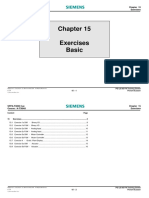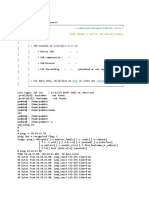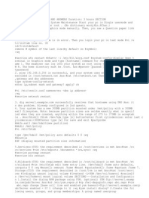0 ratings0% found this document useful (0 votes)
31 viewsChiru 2
Chiru 2
Uploaded by
RAZThe document shows the configuration of user and group accounts on a Linux system. It creates new user and group accounts including sapsys, dba, and oinstall groups with IDs 3701, 4701, and 4702. It then creates directories for different applications under the /home directory and adds a user sidadm to the sapsys and dba groups with details like UID 3601 and password.
Copyright:
© All Rights Reserved
Available Formats
Download as TXT, PDF, TXT or read online from Scribd
Chiru 2
Chiru 2
Uploaded by
RAZ0 ratings0% found this document useful (0 votes)
31 views9 pagesThe document shows the configuration of user and group accounts on a Linux system. It creates new user and group accounts including sapsys, dba, and oinstall groups with IDs 3701, 4701, and 4702. It then creates directories for different applications under the /home directory and adds a user sidadm to the sapsys and dba groups with details like UID 3601 and password.
Original Title
chiru2
Copyright
© © All Rights Reserved
Available Formats
TXT, PDF, TXT or read online from Scribd
Share this document
Did you find this document useful?
Is this content inappropriate?
The document shows the configuration of user and group accounts on a Linux system. It creates new user and group accounts including sapsys, dba, and oinstall groups with IDs 3701, 4701, and 4702. It then creates directories for different applications under the /home directory and adds a user sidadm to the sapsys and dba groups with details like UID 3601 and password.
Copyright:
© All Rights Reserved
Available Formats
Download as TXT, PDF, TXT or read online from Scribd
Download as txt, pdf, or txt
0 ratings0% found this document useful (0 votes)
31 views9 pagesChiru 2
Chiru 2
Uploaded by
RAZThe document shows the configuration of user and group accounts on a Linux system. It creates new user and group accounts including sapsys, dba, and oinstall groups with IDs 3701, 4701, and 4702. It then creates directories for different applications under the /home directory and adds a user sidadm to the sapsys and dba groups with details like UID 3601 and password.
Copyright:
© All Rights Reserved
Available Formats
Download as TXT, PDF, TXT or read online from Scribd
Download as txt, pdf, or txt
You are on page 1of 9
login as: root
Keyboard-interactive authentication prompts from server:
| Password:
End of keyboard-interactive prompts from server
Last login: Thu Jun 30 02:34:37 2022 from 192.168.232.1
localhost:~ # groupadd -g 3701 sapsys
localhost:~ # cat /etc/group
root:x:0:
shadow:x:15:vnc
trusted:x:42:
users:x:100:
tss:x:98:
messagebus:x:499:
nogroup:x:65533:
nobody:x:65534:
man:x:62:
mail:!:498:postfix
daemon:x:2:
wheel:x:497:
kvm:x:36:qemu
kmem:x:496:
lock:x:495:
tty:x:5:
utmp:x:494:
audio:x:493:pulse
cdrom:x:492:
dialout:x:491:
disk:x:490:
input:x:489:
lp:x:488:
render:x:487:
tape:x:486:
video:x:485:gdm
audit:x:484:
tftp:x:483:tftp,dnsmasq
maildrop:x:59:postfix
postfix:x:51:
bin:x:1:daemon
sshd:!:482:
srvGeoClue:!:481:
flatpak:!:480:
libvirt:x:108:
qemu:x:107:
polkitd:x:479:
brlapi:x:478:
rtkit:x:477:
systemd-journal:x:476:
systemd-network:x:475:
systemd-resolve:x:474:
systemd-timesync:x:473:
systemd-coredump:x:472:
nscd:x:471:
scard:x:470:
ntadmin:x:71:
chrony:x:469:
pulse:x:468:
pulse-access:x:467:
colord:x:466:
nm-openvpn:x:465:
nm-openconnect:x:464:
vnc:x:463:
gdm:x:462:
sapsys:x:3701:
localhost:~ # groupadd -g 4701 dba
localhost:~ # cat /etc/group
root:x:0:
shadow:x:15:vnc
trusted:x:42:
users:x:100:
tss:x:98:
messagebus:x:499:
nogroup:x:65533:
nobody:x:65534:
man:x:62:
mail:!:498:postfix
daemon:x:2:
wheel:x:497:
kvm:x:36:qemu
kmem:x:496:
lock:x:495:
tty:x:5:
utmp:x:494:
audio:x:493:pulse
cdrom:x:492:
dialout:x:491:
disk:x:490:
input:x:489:
lp:x:488:
render:x:487:
tape:x:486:
video:x:485:gdm
audit:x:484:
tftp:x:483:tftp,dnsmasq
maildrop:x:59:postfix
postfix:x:51:
bin:x:1:daemon
sshd:!:482:
srvGeoClue:!:481:
flatpak:!:480:
libvirt:x:108:
qemu:x:107:
polkitd:x:479:
brlapi:x:478:
rtkit:x:477:
systemd-journal:x:476:
systemd-network:x:475:
systemd-resolve:x:474:
systemd-timesync:x:473:
systemd-coredump:x:472:
nscd:x:471:
scard:x:470:
ntadmin:x:71:
chrony:x:469:
pulse:x:468:
pulse-access:x:467:
colord:x:466:
nm-openvpn:x:465:
nm-openconnect:x:464:
vnc:x:463:
gdm:x:462:
sapsys:x:3701:
dba:x:4701:
localhost:~ # groupadd -g 4702 oinstall
localhost:~ # cat /etc/group
root:x:0:
shadow:x:15:vnc
trusted:x:42:
users:x:100:
tss:x:98:
messagebus:x:499:
nogroup:x:65533:
nobody:x:65534:
man:x:62:
mail:!:498:postfix
daemon:x:2:
wheel:x:497:
kvm:x:36:qemu
kmem:x:496:
lock:x:495:
tty:x:5:
utmp:x:494:
audio:x:493:pulse
cdrom:x:492:
dialout:x:491:
disk:x:490:
input:x:489:
lp:x:488:
render:x:487:
tape:x:486:
video:x:485:gdm
audit:x:484:
tftp:x:483:tftp,dnsmasq
maildrop:x:59:postfix
postfix:x:51:
bin:x:1:daemon
sshd:!:482:
srvGeoClue:!:481:
flatpak:!:480:
libvirt:x:108:
qemu:x:107:
polkitd:x:479:
brlapi:x:478:
rtkit:x:477:
systemd-journal:x:476:
systemd-network:x:475:
systemd-resolve:x:474:
systemd-timesync:x:473:
systemd-coredump:x:472:
nscd:x:471:
scard:x:470:
ntadmin:x:71:
chrony:x:469:
pulse:x:468:
pulse-access:x:467:
colord:x:466:
nm-openvpn:x:465:
nm-openconnect:x:464:
vnc:x:463:
gdm:x:462:
sapsys:x:3701:
dba:x:4701:
oinstall:x:4702:
localhost:~ # cd home
-bash: cd: home: No such file or directory
localhost:~ # mkdir home
localhost:~ # cd home
localhost:~/home # mkdir sidadm sapadm daaadm oracel orasid
localhost:~/home # ll
total 0
drwxr-xr-x 2 root root 6 Jun 30 13:50 daaadm
drwxr-xr-x 2 root root 6 Jun 30 13:50 oracel
drwxr-xr-x 2 root root 6 Jun 30 13:50 orasid
drwxr-xr-x 2 root root 6 Jun 30 13:50 sapadm
drwxr-xr-x 2 root root 6 Jun 30 13:50 sidadm
localhost:~/home # cd ~
localhost:~ # pwd
/root
localhost:~ # cd ..
localhost:/ # cd ~
localhost:~ # cat /etc/group
root:x:0:
shadow:x:15:vnc
trusted:x:42:
users:x:100:
tss:x:98:
messagebus:x:499:
nogroup:x:65533:
nobody:x:65534:
man:x:62:
mail:!:498:postfix
daemon:x:2:
wheel:x:497:
kvm:x:36:qemu
kmem:x:496:
lock:x:495:
tty:x:5:
utmp:x:494:
audio:x:493:pulse
cdrom:x:492:
dialout:x:491:
disk:x:490:
input:x:489:
lp:x:488:
render:x:487:
tape:x:486:
video:x:485:gdm
audit:x:484:
tftp:x:483:tftp,dnsmasq
maildrop:x:59:postfix
postfix:x:51:
bin:x:1:daemon
sshd:!:482:
srvGeoClue:!:481:
flatpak:!:480:
libvirt:x:108:
qemu:x:107:
polkitd:x:479:
brlapi:x:478:
rtkit:x:477:
systemd-journal:x:476:
systemd-network:x:475:
systemd-resolve:x:474:
systemd-timesync:x:473:
systemd-coredump:x:472:
nscd:x:471:
scard:x:470:
ntadmin:x:71:
chrony:x:469:
pulse:x:468:
pulse-access:x:467:
colord:x:466:
nm-openvpn:x:465:
nm-openconnect:x:464:
vnc:x:463:
gdm:x:462:
sapsys:x:3701:
dba:x:4701:
oinstall:x:4702:
localhost:~ # useradd -u 3601 -g sapsys -G dba -e 20221030 -c "sap application
admin user" -d /home/sidadm -p Welcome123 sidadm
localhost:~ # cat /etc/passwd
bin:x:1:1:bin:/bin:/sbin/nologin
chrony:x:491:469:Chrony Daemon:/var/lib/chrony:/bin/false
colord:x:488:466:user for colord:/var/lib/colord:/sbin/nologin
daemon:x:2:2:Daemon:/sbin:/sbin/nologin
dnsmasq:x:496:65533:dnsmasq:/var/lib/empty:/bin/false
flatpak:x:492:480:Flatpak system helper:/home/flatpak:/sbin/nologin
gdm:x:484:462:Gnome Display Manager daemon:/var/lib/gdm:/bin/false
gnome-initial-setup:x:483:100::/run/gnome-initial-setup/:/sbin/nologin
lp:x:495:488:Printing daemon:/var/spool/lpd:/sbin/nologin
mail:x:498:498:Mailer daemon:/var/spool/clientmqueue:/sbin/nologin
man:x:13:62:Manual pages viewer:/var/lib/empty:/sbin/nologin
messagebus:x:499:499:User for D-Bus:/run/dbus:/usr/bin/false
nm-openconnect:x:486:464:NetworkManager user for OpenConnect:/var/lib/nm-
openconnect:/sbin/nologin
nm-openvpn:x:487:465:NetworkManager user for OpenVPN:/var/lib/openvpn:/sbin/nologin
nobody:x:65534:65534:nobody:/var/lib/nobody:/bin/bash
nscd:x:102:471:User for nscd:/run/nscd:/sbin/nologin
polkitd:x:106:479:User for polkitd:/var/lib/polkit:/sbin/nologin
postfix:x:51:51:Postfix Daemon:/var/spool/postfix:/sbin/nologin
pulse:x:490:468:PulseAudio daemon:/var/lib/pulseaudio:/sbin/nologin
qemu:x:107:107:qemu user:/home/qemu:/sbin/nologin
radvd:x:103:100:Router ADVertisement Daemon for:/var/lib/empty:/sbin/nologin
root:x:0:0:root:/root:/bin/bash
rpc:x:104:65534:user for rpcbind:/var/lib/empty:/sbin/nologin
rtkit:x:105:477:RealtimeKit:/proc:/bin/false
scard:x:100:470:Smart Card Reader:/var/run/pcscd:/usr/sbin/nologin
srvGeoClue:x:493:481:User for GeoClue D-Bus
service:/var/lib/srvGeoClue:/sbin/nologin
sshd:x:494:482:SSH daemon:/var/lib/sshd:/sbin/nologin
statd:x:101:65533:NFS statd daemon:/var/lib/nfs:/sbin/nologin
systemd-coredump:x:472:472:systemd Core Dumper:/:/usr/sbin/nologin
systemd-network:x:475:475:systemd Network Management:/:/usr/sbin/nologin
systemd-resolve:x:474:474:systemd Resolver:/:/usr/sbin/nologin
systemd-timesync:x:473:473:systemd Time Synchronization:/:/usr/sbin/nologin
tftp:x:497:483:TFTP account:/srv/tftpboot:/bin/false
tss:x:98:98:TSS daemon:/var/lib/tpm:/bin/false
usbmux:x:489:65533:usbmuxd daemon:/var/lib/usbmuxd:/sbin/nologin
vnc:x:485:463:user for VNC:/var/lib/empty:/sbin/nologin
jrktrainings:x:1000:100:jrktrainings:/home/jrktrainings:/bin/bash
sidadm:x:3601:3701:sap application admin user:/home/sidadm:/bin/bash
localhost:~ # 192.168.232.128
If '192.168.232.128' is not a typo you can use command-not-found to lookup the
package that contains it, like this:
cnf 192.168.232.128
localhost:~ # cat /etc/gshadow
cat: /etc/gshadow: No such file or directory
localhost:~ # cat --help
Usage: cat [OPTION]... [FILE]...
Concatenate FILE(s) to standard output.
With no FILE, or when FILE is -, read standard input.
-A, --show-all equivalent to -vET
-b, --number-nonblank number nonempty output lines, overrides -n
-e equivalent to -vE
-E, --show-ends display $ at end of each line
-n, --number number all output lines
-s, --squeeze-blank suppress repeated empty output lines
-t equivalent to -vT
-T, --show-tabs display TAB characters as ^I
-u (ignored)
-v, --show-nonprinting use ^ and M- notation, except for LFD and TAB
--help display this help and exit
--version output version information and exit
Examples:
cat f - g Output f's contents, then standard input, then g's contents.
cat Copy standard input to standard output.
GNU coreutils online help: <https://www.gnu.org/software/coreutils/>
Report any translation bugs to <https://translationproject.org/team/>
Full documentation <https://www.gnu.org/software/coreutils/cat>
or available locally via: info '(coreutils) cat invocation'
localhost:~ # cat /etc/shadow
bin:!:19164::::::
chrony:!:19164::::::
colord:!:19164::::::
daemon:!:19164::::::
dnsmasq:!:19164::::::
flatpak:!:19164::::::
gdm:!:19164::::::
gnome-initial-setup:!:19164::::::
lp:!:19164::::::
mail:!:19164::::::
man:!:19164::::::
messagebus:!:19164::::::
nm-openconnect:!:19164::::::
nm-openvpn:!:19164::::::
nobody:!:19164::::::
nscd:!:19164::::::
polkitd:!:19164::::::
postfix:!:19164::::::
pulse:!:19164::::::
qemu:!:19164::::::
radvd:!:19164::::::
root:$6$4d6H/bS/
1kP7KB30$Nl7pDdLtHQMYhpBWBybmQmoPfF4xLMgN0ST2vduFbTrHw.aErCv8EeYHXgj1rPZOi5Y9vT6nPW
OREF0q9mWf//:19164::::::
rpc:!:19164::::::
rtkit:!:19164::::::
scard:!:19164::::::
srvGeoClue:!:19164::::::
sshd:!:19164::::::
statd:!:19164::::::
systemd-coredump:!*:19164::::::
systemd-network:!*:19164::::::
systemd-resolve:!*:19164::::::
systemd-timesync:!*:19164::::::
tftp:!:19164::::::
tss:!:19164:0:99999:7:::
usbmux:!:19164::::::
vnc:!:19164::::::
jrktrainings:
$6$CGma8CO8x8UeY8Sy$L7Lj5O5y.iIz6culOEEMXRjgB5A4n0Lt4TZntb0bnyjNhPSBxvI5M0/3fTt.KOd
kIIiHlvm.yGvuIsWdBjTyh.:19164:0:99999:7:::
sidadm:Welcome123:19173:0:99999:7::20221030:
localhost:~ # cat /etc/group
root:x:0:
shadow:x:15:vnc
trusted:x:42:
users:x:100:
tss:x:98:
messagebus:x:499:
nogroup:x:65533:
nobody:x:65534:
man:x:62:
mail:!:498:postfix
daemon:x:2:
wheel:x:497:
kvm:x:36:qemu
kmem:x:496:
lock:x:495:
tty:x:5:
utmp:x:494:
audio:x:493:pulse
cdrom:x:492:
dialout:x:491:
disk:x:490:
input:x:489:
lp:x:488:
render:x:487:
tape:x:486:
video:x:485:gdm
audit:x:484:
tftp:x:483:tftp,dnsmasq
maildrop:x:59:postfix
postfix:x:51:
bin:x:1:daemon
sshd:!:482:
srvGeoClue:!:481:
flatpak:!:480:
libvirt:x:108:
qemu:x:107:
polkitd:x:479:
brlapi:x:478:
rtkit:x:477:
systemd-journal:x:476:
systemd-network:x:475:
systemd-resolve:x:474:
systemd-timesync:x:473:
systemd-coredump:x:472:
nscd:x:471:
scard:x:470:
ntadmin:x:71:
chrony:x:469:
pulse:x:468:
pulse-access:x:467:
colord:x:466:
nm-openvpn:x:465:
nm-openconnect:x:464:
vnc:x:463:
gdm:x:462:
sapsys:x:3701:
dba:x:4701:sidadm
oinstall:x:4702:
localhost:~ # useradd -u 3602 -g 3701 -G 4701 -c "sap host agent admin user" -d
/home/sapadm/ -p Welcome123 sapadm
localhost:~ # cat /etc/passwd
bin:x:1:1:bin:/bin:/sbin/nologin
chrony:x:491:469:Chrony Daemon:/var/lib/chrony:/bin/false
colord:x:488:466:user for colord:/var/lib/colord:/sbin/nologin
daemon:x:2:2:Daemon:/sbin:/sbin/nologin
dnsmasq:x:496:65533:dnsmasq:/var/lib/empty:/bin/false
flatpak:x:492:480:Flatpak system helper:/home/flatpak:/sbin/nologin
gdm:x:484:462:Gnome Display Manager daemon:/var/lib/gdm:/bin/false
gnome-initial-setup:x:483:100::/run/gnome-initial-setup/:/sbin/nologin
lp:x:495:488:Printing daemon:/var/spool/lpd:/sbin/nologin
mail:x:498:498:Mailer daemon:/var/spool/clientmqueue:/sbin/nologin
man:x:13:62:Manual pages viewer:/var/lib/empty:/sbin/nologin
messagebus:x:499:499:User for D-Bus:/run/dbus:/usr/bin/false
nm-openconnect:x:486:464:NetworkManager user for OpenConnect:/var/lib/nm-
openconnect:/sbin/nologin
nm-openvpn:x:487:465:NetworkManager user for OpenVPN:/var/lib/openvpn:/sbin/nologin
nobody:x:65534:65534:nobody:/var/lib/nobody:/bin/bash
nscd:x:102:471:User for nscd:/run/nscd:/sbin/nologin
polkitd:x:106:479:User for polkitd:/var/lib/polkit:/sbin/nologin
postfix:x:51:51:Postfix Daemon:/var/spool/postfix:/sbin/nologin
pulse:x:490:468:PulseAudio daemon:/var/lib/pulseaudio:/sbin/nologin
qemu:x:107:107:qemu user:/home/qemu:/sbin/nologin
radvd:x:103:100:Router ADVertisement Daemon for:/var/lib/empty:/sbin/nologin
root:x:0:0:root:/root:/bin/bash
rpc:x:104:65534:user for rpcbind:/var/lib/empty:/sbin/nologin
rtkit:x:105:477:RealtimeKit:/proc:/bin/false
scard:x:100:470:Smart Card Reader:/var/run/pcscd:/usr/sbin/nologin
srvGeoClue:x:493:481:User for GeoClue D-Bus
service:/var/lib/srvGeoClue:/sbin/nologin
sshd:x:494:482:SSH daemon:/var/lib/sshd:/sbin/nologin
statd:x:101:65533:NFS statd daemon:/var/lib/nfs:/sbin/nologin
systemd-coredump:x:472:472:systemd Core Dumper:/:/usr/sbin/nologin
systemd-network:x:475:475:systemd Network Management:/:/usr/sbin/nologin
systemd-resolve:x:474:474:systemd Resolver:/:/usr/sbin/nologin
systemd-timesync:x:473:473:systemd Time Synchronization:/:/usr/sbin/nologin
tftp:x:497:483:TFTP account:/srv/tftpboot:/bin/false
tss:x:98:98:TSS daemon:/var/lib/tpm:/bin/false
usbmux:x:489:65533:usbmuxd daemon:/var/lib/usbmuxd:/sbin/nologin
vnc:x:485:463:user for VNC:/var/lib/empty:/sbin/nologin
jrktrainings:x:1000:100:jrktrainings:/home/jrktrainings:/bin/bash
sidadm:x:3601:3701:sap application admin user:/home/sidadm:/bin/bash
sapadm:x:3602:3701:sap host agent admin user:/home/sapadm/:/bin/bash
localhost:~ # cat /etc/shadow
bin:!:19164::::::
chrony:!:19164::::::
colord:!:19164::::::
daemon:!:19164::::::
dnsmasq:!:19164::::::
flatpak:!:19164::::::
gdm:!:19164::::::
gnome-initial-setup:!:19164::::::
lp:!:19164::::::
mail:!:19164::::::
man:!:19164::::::
messagebus:!:19164::::::
nm-openconnect:!:19164::::::
nm-openvpn:!:19164::::::
nobody:!:19164::::::
nscd:!:19164::::::
polkitd:!:19164::::::
postfix:!:19164::::::
pulse:!:19164::::::
qemu:!:19164::::::
radvd:!:19164::::::
root:$6$4d6H/bS/
1kP7KB30$Nl7pDdLtHQMYhpBWBybmQmoPfF4xLMgN0ST2vduFbTrHw.aErCv8EeYHXgj1rPZOi5Y9vT6nPW
OREF0q9mWf//:19164::::::
rpc:!:19164::::::
rtkit:!:19164::::::
scard:!:19164::::::
srvGeoClue:!:19164::::::
sshd:!:19164::::::
statd:!:19164::::::
systemd-coredump:!*:19164::::::
systemd-network:!*:19164::::::
systemd-resolve:!*:19164::::::
systemd-timesync:!*:19164::::::
tftp:!:19164::::::
tss:!:19164:0:99999:7:::
usbmux:!:19164::::::
vnc:!:19164::::::
jrktrainings:
$6$CGma8CO8x8UeY8Sy$L7Lj5O5y.iIz6culOEEMXRjgB5A4n0Lt4TZntb0bnyjNhPSBxvI5M0/3fTt.KOd
kIIiHlvm.yGvuIsWdBjTyh.:19164:0:99999:7:::
sidadm:Welcome123:19173:0:99999:7::20221030:
sapadm:Welcome123:19173:0:99999:7:::
localhost:~ #
You might also like
- Off ShoreDocument18 pagesOff ShoreJean Pierre50% (10)
- OSCP-EXAM Hide01.irDocument4 pagesOSCP-EXAM Hide01.irYamen AbabnehNo ratings yet
- Hades EndgameDocument42 pagesHades EndgameJean PierreNo ratings yet
- 15 Exercises BasicDocument8 pages15 Exercises Basictaguma PEDZISAINo ratings yet
- Bank Account ManagmeDocument54 pagesBank Account ManagmeSurani shai100% (1)
- Autolisp Programming Notes PDFDocument23 pagesAutolisp Programming Notes PDFShridhar NaganeNo ratings yet
- Esharmaji Walkthrough VulniversityDocument6 pagesEsharmaji Walkthrough Vulniversitymovie hunterNo ratings yet
- 05 Linux Access ControlDocument10 pages05 Linux Access Controlnickespro130No ratings yet
- Chiru 3Document8 pagesChiru 3RAZNo ratings yet
- M - WAGEEH Make USB Bootable For AIX - VIOS Total On VIODocument12 pagesM - WAGEEH Make USB Bootable For AIX - VIOS Total On VIOMohamed Wageeh DiabNo ratings yet
- DictionaryDocument1 pageDictionaryjhjhNo ratings yet
- Hardinfo Report RochmaliaDocument12 pagesHardinfo Report RochmaliaRochmaliah LiaNo ratings yet
- Decoded 2Document1 pageDecoded 2jspwantsrobuxNo ratings yet
- Diagnostics ReportDocument286 pagesDiagnostics Reportthiago.cortezNo ratings yet
- BluetoothDocument3 pagesBluetoothJennifer PowellNo ratings yet
- 02 Linux CommandsDocument10 pages02 Linux CommandsLuis BattaNo ratings yet
- Linux Oracle12c Installation With All Command Output MypracticeDocument17 pagesLinux Oracle12c Installation With All Command Output MypracticeRaihanNo ratings yet
- Logs P&BDocument21 pagesLogs P&BRichard IriarteNo ratings yet
- DBA Sheet v5.8Document419 pagesDBA Sheet v5.8a singhNo ratings yet
- MobaXterm 192.168.195.131 20240420 163051Document666 pagesMobaXterm 192.168.195.131 20240420 163051ishygo99No ratings yet
- Are They Talking To Each OtherDocument29 pagesAre They Talking To Each Otherhen diaoNo ratings yet
- OSCP Survival GuideDocument63 pagesOSCP Survival Guidesetyahangga3No ratings yet
- MobaXterm AMF 20201015 193011Document16 pagesMobaXterm AMF 20201015 193011Gurudeep BNNo ratings yet
- Tugas Akhir - MSGDocument2 pagesTugas Akhir - MSGAidil AzharNo ratings yet
- MobaXterm 192.168.195.131 20240420 001136Document135 pagesMobaXterm 192.168.195.131 20240420 001136ishygo99No ratings yet
- X-Plane Installer LogDocument7 pagesX-Plane Installer LogMatheus MuradNo ratings yet
- Cross Compile QT5 SourcesDocument13 pagesCross Compile QT5 Sourcesap8389546No ratings yet
- Common Tools and Methods Used in Vulnhub CTF'sDocument4 pagesCommon Tools and Methods Used in Vulnhub CTF'spipiiiiiiiNo ratings yet
- MobaXterm 192.168.195.131 20240420 010348Document272 pagesMobaXterm 192.168.195.131 20240420 010348ishygo99No ratings yet
- FAQ LostCoinsDocument20 pagesFAQ LostCoinsToots AsensiNo ratings yet
- Rhce Question and AswerDocument6 pagesRhce Question and AswerBana LiviNo ratings yet
- OSCP Survival GuideDocument48 pagesOSCP Survival GuideMy Shop BackNo ratings yet
- UntitledDocument2 pagesUntitledSenthamizh Selvan SNo ratings yet
- OS4k Linux Commands PDFDocument17 pagesOS4k Linux Commands PDFKC KCNo ratings yet
- Docker ComposeDocument8 pagesDocker Compose_lockaNo ratings yet
- Killer Shell - Exam SimulatorsDocument51 pagesKiller Shell - Exam SimulatorsnajlaNo ratings yet
- MobaXterm SMF 20201015 193005Document38 pagesMobaXterm SMF 20201015 193005Gurudeep BNNo ratings yet
- Report On VM 2 Ip:-144.244.143.144 Name:sathya Sachi Paira: Nmap - P - A 143.244.143.144Document13 pagesReport On VM 2 Ip:-144.244.143.144 Name:sathya Sachi Paira: Nmap - P - A 143.244.143.144Saumay SrivastavaNo ratings yet
- Learn To Design Your Own ARM Boards FEDEVELDocument30 pagesLearn To Design Your Own ARM Boards FEDEVELasiankid26No ratings yet
- MobaXterm Cubin 20201015 192940Document51 pagesMobaXterm Cubin 20201015 192940Gurudeep BNNo ratings yet
- Autorun Verus MinerDocument2 pagesAutorun Verus MinerandiNo ratings yet
- Build - OpenCPN - UpdateDocument6 pagesBuild - OpenCPN - UpdateNguyễn Hoàng Trọng NhânNo ratings yet
- PPPo EDocument21 pagesPPPo EKavitha ChelladhuraiNo ratings yet
- Bpftools2017 190108214100Document44 pagesBpftools2017 190108214100csy365No ratings yet
- Group & Password With Screen Shot Ecc Biw SRMDocument18 pagesGroup & Password With Screen Shot Ecc Biw SRMNitesh KohliNo ratings yet
- MobaXterm 192.168.195.131 20240419 232151Document40 pagesMobaXterm 192.168.195.131 20240419 232151ishygo99No ratings yet
- MobaXterm 192.168.195.131 20240419 222757Document30 pagesMobaXterm 192.168.195.131 20240419 222757ishygo99No ratings yet
- Instalacion de OpenKM 01Document54 pagesInstalacion de OpenKM 01Jose PintadoNo ratings yet
- HHJDocument2 pagesHHJnjarambaNo ratings yet
- Daemonize An Existing TCP ServerDocument10 pagesDaemonize An Existing TCP ServerknightmknightNo ratings yet
- FilipPalian - MateuszKocielski. Simplest Ownage Human Observed RoutersDocument62 pagesFilipPalian - MateuszKocielski. Simplest Ownage Human Observed RoutersYury ChemerkinNo ratings yet
- 5 System Startup and ShutdownDocument17 pages5 System Startup and ShutdownDevender RajuNo ratings yet
- Os Week 9Document6 pagesOs Week 9Movie explained in KannadaNo ratings yet
- ABD00 Notebooks Combined - DatabricksDocument109 pagesABD00 Notebooks Combined - DatabricksBruno TelesNo ratings yet
- CmospwdDocument5 pagesCmospwdMarimantia DiarraNo ratings yet
- DX DiagDocument18 pagesDX Diagraymond_lau0706No ratings yet
- Rennel PCDocument13 pagesRennel PCWestly JucoNo ratings yet
- ArchDocument4 pagesArchbenjohnsonnnn6891No ratings yet
- Huawei/Vodafone 3G USB Modem On Asterisk-DatacardDocument9 pagesHuawei/Vodafone 3G USB Modem On Asterisk-DatacardRui MoreiraNo ratings yet
- X-Plane Installer LogDocument4 pagesX-Plane Installer Logmkyhbgn2x2No ratings yet
- Các lệnh cơ bản dùng trong BackTrackDocument24 pagesCác lệnh cơ bản dùng trong BackTrackmanhvokiemNo ratings yet
- CISCO PACKET TRACER LABS: Best practice of configuring or troubleshooting NetworkFrom EverandCISCO PACKET TRACER LABS: Best practice of configuring or troubleshooting NetworkNo ratings yet
- Notification For Jag Entry Scheme 32 Apr 2024 CourseDocument9 pagesNotification For Jag Entry Scheme 32 Apr 2024 CourseRAZNo ratings yet
- App Note For DigitalDocument2 pagesApp Note For DigitalRAZNo ratings yet
- NIN Various Vacancy PotsDocument1 pageNIN Various Vacancy PotsRAZNo ratings yet
- Notification Indian Air Force Agniveer Vayu Intake 01 2024Document2 pagesNotification Indian Air Force Agniveer Vayu Intake 01 2024RAZNo ratings yet
- Notification TSNPDCL JR Asst Cum Computer Operator PostsDocument18 pagesNotification TSNPDCL JR Asst Cum Computer Operator PostsRAZNo ratings yet
- Notification KMC Health Officer VacancyDocument4 pagesNotification KMC Health Officer VacancyRAZNo ratings yet
- Notification TSTRANSCO Graduate and Diploma Apprentice PostsDocument3 pagesNotification TSTRANSCO Graduate and Diploma Apprentice PostsRAZNo ratings yet
- 0 638242381327550000 NoticeFILEDocument5 pages0 638242381327550000 NoticeFILERAZNo ratings yet
- Short Notification TREI RB Music Teacher PostsDocument1 pageShort Notification TREI RB Music Teacher PostsRAZNo ratings yet
- Notification BSNL Graduate Technical Apprentice 2023Document6 pagesNotification BSNL Graduate Technical Apprentice 2023RAZNo ratings yet
- Notification Barrackpore Asha Worker PostsDocument8 pagesNotification Barrackpore Asha Worker PostsRAZNo ratings yet
- Notification North 24 Parganas Office of The Sub Divisional Officer Asha Worker PostsDocument14 pagesNotification North 24 Parganas Office of The Sub Divisional Officer Asha Worker PostsRAZNo ratings yet
- Notification TREI RB PGT PostsDocument1 pageNotification TREI RB PGT PostsRAZNo ratings yet
- Notification Incoe Tax Department Kanpur Various Posts 2023Document14 pagesNotification Incoe Tax Department Kanpur Various Posts 2023RAZNo ratings yet
- Short Notification Indian Army Technical Graduate Course January 2024Document1 pageShort Notification Indian Army Technical Graduate Course January 2024RAZNo ratings yet
- Notification NEIAH Various VacancyDocument5 pagesNotification NEIAH Various VacancyRAZNo ratings yet
- Notification and Application Form HaryanaJobs - in Army HQ Southern Command Signals CSBO Recruitment 2023Document2 pagesNotification and Application Form HaryanaJobs - in Army HQ Southern Command Signals CSBO Recruitment 2023RAZNo ratings yet
- Notification RBI Pharmacist Vacancy 2023Document9 pagesNotification RBI Pharmacist Vacancy 2023RAZNo ratings yet
- Notification JSSC Lab Assistant PostsDocument41 pagesNotification JSSC Lab Assistant PostsRAZNo ratings yet
- Notification Vizianagaram DCCB Manager PostsDocument20 pagesNotification Vizianagaram DCCB Manager PostsRAZNo ratings yet
- Notification AAI Various Vacancy PostsDocument9 pagesNotification AAI Various Vacancy PostsRAZNo ratings yet
- 9Document1 page9RAZNo ratings yet
- Detailed AdvertisementDocument17 pagesDetailed AdvertisementRAZNo ratings yet
- Notification AIATSL Various Vacncy PostsDocument21 pagesNotification AIATSL Various Vacncy PostsRAZNo ratings yet
- Notification IIM Raipur Non Teaching Posts 2023Document8 pagesNotification IIM Raipur Non Teaching Posts 2023RAZNo ratings yet
- Notification IISER Principal Teacher Other PostsDocument8 pagesNotification IISER Principal Teacher Other PostsRAZNo ratings yet
- 6Document1 page6RAZNo ratings yet
- S.No State Region SC ST OBC EWS GEN Total HI OC VI: 2. Details of Districts Under Each Region Is Attached As AnnexureDocument1 pageS.No State Region SC ST OBC EWS GEN Total HI OC VI: 2. Details of Districts Under Each Region Is Attached As AnnexureRAZNo ratings yet
- Branches Stipend Diem Allowance: Incurred On Public TransportDocument1 pageBranches Stipend Diem Allowance: Incurred On Public TransportRAZNo ratings yet
- S.No State Region ST OBC EWS GEN Total HI OC VIDocument1 pageS.No State Region ST OBC EWS GEN Total HI OC VIRAZNo ratings yet
- Accessing Linux File SystemsDocument8 pagesAccessing Linux File SystemspmmanickNo ratings yet
- CONVEX User GuideDocument14 pagesCONVEX User Guidejoncoyne.1979No ratings yet
- Social Changes and Challenges Brought by The 4th Industrial RevolutionDocument8 pagesSocial Changes and Challenges Brought by The 4th Industrial RevolutionVictoria Antonette100% (2)
- Transport Level Security PresentationDocument30 pagesTransport Level Security PresentationAhimbisibwe BakerNo ratings yet
- Webex SuiteDocument17 pagesWebex SuiterbknkjrxqdNo ratings yet
- Chapter 5 DBMSDocument22 pagesChapter 5 DBMSanNo ratings yet
- Css 10 WHLP 1st QuarterDocument5 pagesCss 10 WHLP 1st Quarternaygela0% (1)
- Azure Key Vault Integration With IICSDocument23 pagesAzure Key Vault Integration With IICSOrachai TassanamethinNo ratings yet
- Manipal Trutest - Brand BookDocument17 pagesManipal Trutest - Brand BookDigital Marketing Manipal TRUtestNo ratings yet
- Computational Thinking: Tim Penyusun Materi Pengenalan Komputasi Institut Teknologi Bandung © 2019Document28 pagesComputational Thinking: Tim Penyusun Materi Pengenalan Komputasi Institut Teknologi Bandung © 2019faizahNo ratings yet
- 01 Working in Move DownLoadLy - IrDocument35 pages01 Working in Move DownLoadLy - IrKevin JaimesNo ratings yet
- CSE3001Document34 pagesCSE3001Majety S LskshmiNo ratings yet
- Self Study For ESP CoursesDocument13 pagesSelf Study For ESP Coursesh85452426No ratings yet
- EXPEDITION COMMON Command Line Interface Reference ManualDocument396 pagesEXPEDITION COMMON Command Line Interface Reference Manualdez ixipuNo ratings yet
- Tracker UtorrentDocument6 pagesTracker Utorrentizequiel freitasNo ratings yet
- Definitions: Bigbasket Privacy PolicyDocument15 pagesDefinitions: Bigbasket Privacy PolicyKing NeelNo ratings yet
- Tanvi PM ChallengeDocument9 pagesTanvi PM ChallengeSURABHI BHUYAN 104KBNo ratings yet
- Wired ControllerDocument6 pagesWired ControllerVictor AANo ratings yet
- Chapter 5 Lab 5-2 - DHCP: TopologyDocument7 pagesChapter 5 Lab 5-2 - DHCP: TopologyMontreal DesNo ratings yet
- Sophos Intercept X DSDocument2 pagesSophos Intercept X DSDXL SolutionsNo ratings yet
- Ashwini YachaDocument2 pagesAshwini YachaashwiniNo ratings yet
- KyleOPEN Custom ROM For Samsung Galaxy S Duos S7562Document6 pagesKyleOPEN Custom ROM For Samsung Galaxy S Duos S7562sssbulbulNo ratings yet
- MiniProject Assignment 3Document3 pagesMiniProject Assignment 3Asadullah ChoudharyNo ratings yet
- Docu 80242Document391 pagesDocu 80242Shweta AgarwalNo ratings yet
- Advanced Microeconometrics - Spring 2021 Take Home Exam 2: A Demand and Supply Model of School CompetitionDocument6 pagesAdvanced Microeconometrics - Spring 2021 Take Home Exam 2: A Demand and Supply Model of School CompetitionOscar ArévaloNo ratings yet
- BÀI KIỂM TRA CUỐI ANDROID - NGÔ THỊ NHIDocument25 pagesBÀI KIỂM TRA CUỐI ANDROID - NGÔ THỊ NHINhiNo ratings yet
- Accounting Software: MYOB & XeroDocument4 pagesAccounting Software: MYOB & XeroDah NEPALNo ratings yet























































































































